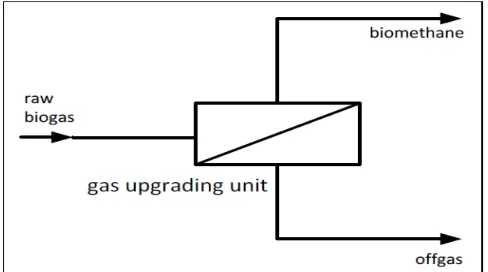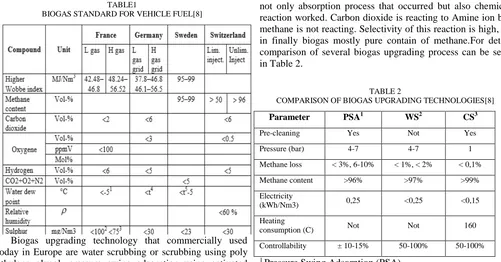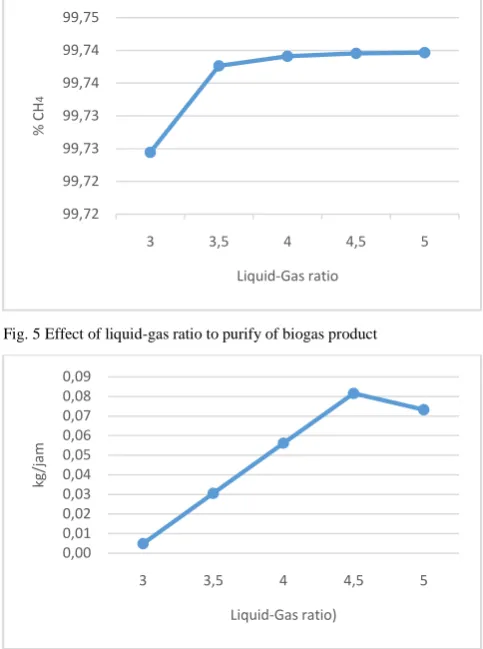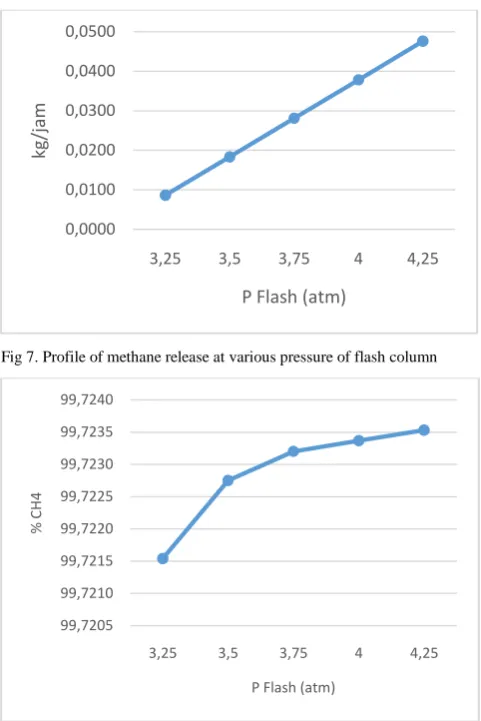Sensitivity Analysis of Water Scrubbing Process for
Biogas Purification
Agung Sugiharto
#, Sarto
*, Sutijan
*, Muslikhin Hidayat
*#
Chemical Engineering, Muhammadiyah University of Surakarta. Jl. A Yani No 1, Surakarta
1
*
Chemical Engineering, Gadjah Mada University.
Jl. Grafika No 2, Yogyakarta
Abstract— For vehicle fuelapplication,biogas need to have high energy content. So, the gas has to be upgraded. The value of energy in the biogas is in direct proportion to the methane concentration. Raw biogas produced by anaerobic digester has methane content about 50-60% and carbon dioxide as main contaminant at 40-50% of volume. The methane content in biogas can be upgraded by carbon dioxide removal process. In contrary, carbon dioxide removal process need cost addition of biogas production. It is important to have an optimized biogas upgrading process in term of low energy consumption and high efficiency giving high methane content in biogas. On the other hand, it is very important to minimize emission of methane from upgrading process because methane have a greenhouse gas effect 23 times greater than carbon dioxide.Water scrubbing is simplest and cheapest technology to produce bio methane using biogas upgrading process.The best control process scenario need to keep the process work in optimal condition. But fluctuation of flow and concentration in biogas produced by anaerobic digester make difficultupgrading process control. By sensitivity analysis study, control scenario for this process can decided in the best way.
Keyword—biogas, carbon dioxide removal, sensitivity analysis, upgrading biogas, water scrubbing.
I. INTRODUCTION
Energy have been essentially need for human live. Electricity, fossil fuel, and natural gas are currently used as main energy source inmodern human live.During the time, as greater amount of human, as greater their energy need. For along time ago until now,human mostly use fossil fuel as energy source for live. This energy source not only is unrenewable but also it amount is going down by the time. Therefore, getting alternative energy resource that renewable is most important.
The research of biogas production through anaerobic digester process from many different feed sources have been done. For example, fruit and beverage waste amount of 3-4 tons/day in Pasar Induk Buah dan Sayuran, Gamping, Sleman, Yogyakarta consist of 12% volatile solid and 86% moisture can produce 300 Nm3/day of biogas [1],[11].This gas product usually do in direct application for domestic used and occasionally for vehicle fuel producing electricity.
Application of raw biogas without upgrading process to vehicle fuel have several disadvantages as mention below: 1.Biogas has only 50-60% of volume of methane so it is not
efficient for direct combustion as fuel.
2.Several contaminant such as H2O and H2S make metal corrosion of equipment.
3.It is less economics. Every cubic meter of biogas that contained65% of methane have caloric value at 6.5 kWh, otherwise for biogas that contained 97% of methane have 9.7 kWh of caloric value [8]. It can be compared to caloric value at 9.8 kWh and 9.1 kWh of diesel oil and petroleum, respectively.
Therefore upgrading biogas for vehicle fuel application is urgently need to equipment corrosion preventing and to reach high caloric value.
II. UTILIZATIONAND PURIFICATION OF BIOGAS
Biogas that can be used as vehicle fuel need to be cleaned and upgraded its energy level.The basic principle of these processes can be seen in Fig 1. Specific goal of these processes are reaching pure biogas containing methane at least 95% of volume and carbon dioxide as main contaminant. Several countries in Europe make standard quality of biogas as vehicle fuel that can be seen in table 1.
TABLE1
BIOGAS STANDARD FOR VEHICLE FUEL[8]
Biogas upgrading technology that commercially used today in Europe are water scrubbing or scrubbing using poly ethylene glycol, pressure swing adsorption using activated carbon or molecular sieve, chemical washing using alcohol amine like Mono Ethanol Amine (MEA) or Dimethyl Ethanol Amine (DEA). Membrane technologyand cryogenic separation at low temperature.
A. Biogas upgrading technology evaluation
To reach methane content at least 95% of volume in biogas, as bio methane, the biogas need to utilize such as cleaning and upgrading process. Although upgrading process of biogas have been well known recently, commercialization of bio methane in Indonesia have not been done. Recently, European country such as Sweden, Germany, France, Holland, and Austria have a pioneer upgrading project. There are several main upgrading processes that commonly used in these country. Physical scrubbing using water or organic solvent, chemical scrubbing using MEA or DEA, and solid adsorption using activated carbon are as favoritebiogas upgrading processes in commercially biogas production. During 2011, the total capacity of water scrubbing was 46,440 Nm3/h, chemical scrubbing was the next popular technology 32,170 Nm3/h and then PSA at 20,230 Nm3/h [5].
Water scrubbing is most simple upgrading process. This process based on different solubility of methane and carbon dioxide in water. Carbon dioxideis more soluble than methane in water, so when biogas is contacting to water, almost of all carbon dioxide in biogas is absorbed to water. At final point, methane content in biogas at least 95% of volume can be reached. In another process, pressure swing adsorption based on different molecular size between methane and carbon dioxide. The molecule size of methane is greater than carbon dioxide, therefore when biogas is flowed through activated carbon media, carbon dioxide molecule will be trapped in activated carbon pores. As result, methane will be dominant content in biogas. In addition, scrubbing using MEA or DEA,
not only absorption process that occurred but also chemical reaction worked. Carbon dioxide is reacting to Amine ion but methane is not reacting. Selectivity of this reaction is high, so in finally biogas mostly pure contain of methane.For detail comparison of several biogas upgrading process can be seen in Table 2.
TABLE 2
COMPARISON OF BIOGAS UPGRADING TECHNOLOGIES[8]
Parameter PSA1 WS2 CS3
Pre-cleaning Yes Not Yes
Pressure (bar) 4-7 4-7 1
Methane loss < 3%, 6-10% < 1%, < 2% < 0,1%
Methane content >96% >97% >99%
Electricity
(kWh/Nm3) 0,25 <0,25 <0,15
Heating
consumption (C) Not Not 160
Controllability ± 10-15% 50-100% 50-100%
1 Pressure Swing Adsorption (PSA) 2 Water Scrubbing (WS)
3 Chemical Scrubbing (CS)
Based on these information, it can be concluded that every upgrading process has advantage and disadvantage itself. Chemical Absorption using amine solution is highly efficient but the process of solvent regeneration usually need high energy consumption. In addition, property of the solvent potentially high equipment corrosion which is not environment friendly [4]. Although the adsorption method does not equipment corrosion and environment pollution, high cost operation, frequent adsorption and desorption process and complex equipment limit its application [6]. Water scrubbing method is physical absorption process. Changing of Carbon dioxide solubility in water depends on the pressure and temperature[7],[3]. So the absorption and desorption of carbon dioxide can be achieved in water. If comparing to another method, scrubbing using water as solvent has advantages such as lower cost, higher stability and safety, and environment friendly.
Pressured water absorption, can clean biogas from CO2,
H2S and NH3 because these component physically solved in
pressured water. Although methane is solved in water, its solubility is lower than CO2, H2S and NH3. In addition,
B. Economic evaluation of biogas upgrading
Economic is main driving factor in industry and it is critical that survival factor for company. It includes information in investment cost, operation cost and specific cost in every stage of biogas upgrading process. The most important factor for economic consideration of biogas production is scale of biogas upgrading plant [10]. Some of the cost data source in this study is footnote from biogas upgrading plant in European countries. It can be seen in Table 3. Because firstly, biogas upgrading project have been done by European countries. To apply this project in Indonesia, it is urgently doing feasibility study. We know that fluctuations of currency exchange highly influence to investment cost and operation cost. On the other side, different cost value of energy and environment issue have high contribution factor for choosing upgrading process. Economic factor such as investment cost, operational cost, and maintenance cost is another factors as consideration for choosing biogas upgrading system. In addition, technical factor such as pilot plant experience, supply of utility water, amount of methane release, and contractor experience cannot be abundant [9]. Not the best upgrading process that we searched but the appropriate process to apply in Indonesia that we need.
TABLE 3.
BIOGAS UPGRADING COST IN VARIOUS TECHNOLOGIES [2]
It can be seen that Table 3giving information which the cheap biogas upgrading cost per Nm3 is water scubbing. If it is combined to technical specification that inform in Table 1, it can be concluded that water scrubbing is the most suitable upgrading process to apply in indonesia. This study is getting the optimum operating condition and how to controlwater scrubbing biogas upgrading process.
III.METHODOLOGY
Biogas purification through water scrubbing based on absorption process using pressured water as solvent. In this study, optimization of absorption process is studied by simulationusing simulation software, Chemcad from Chem Station, inc.There are two factors that influence simulation result.That are thermodynamic model and calculation model. SCDS model of Chemcad is used as calculation model. This model work based on rigorous calculation method. In addition, Wilson thermodynamic model is setted to simulate Vapor-Liquid-Equibrillium (VLE). Because these factors are interesting to decide the simulation result, it is urgently to
validate the thermodynamic model. For validation of thermodinamic model, Experiment data from [13]is used. After that,simulation to sensitivity analysis and optimization is done using this suitable thermodinamic model. In addition,water scrubbing process model to sensitivity analysis simulation and optimization as show in Fig 2.
Fig. 2 Chemcad Mmodel of water scrubbing for biogas upgrading
IV.RESULT AND DISCUSSION
For thermodynamic model verification, simulation is set to process condition that discribed by [13]experiment. The simulation result compaired to experiment data can be seen in Fig 3. It can be seen that wilson thermodynamic model is suitable enough in contrary comparing to PSRK and Henry’s Model. Wilson and Margules are activity coefficient thermodynamic model. On the other side, PSRK is one of Equation of State (EoS) model.The result that shown in Fig 3inform that thermodinamic model based on activity coefficient like Wilson and Margules is suitable to simulate biogas absorbtion using water solvent.
Fig. 3 Wilson thermodynamic model validation
A. Pressure of absorber effect
It is well known that in absorption system, thehigher pressure of absorber, the higher solubility of the gas. So absorption performance is increased. But it is not sure, how is pressure of absorber so effective to performance of absorption process. As illustrate in Fig 4, it can be seen that pressure of absorber greater than 8 atmosphere is not effective enough to gain the performance of absorption carbon dioxide in this system. Therefore set 8 atmosphere as absorber operation pressure is the best choice.
Fig. 4Effect of Absorber Pressure to biogas purification performance
B. Effect of Liquid to Gas ratio of feed
In absorption system, it is commonly known that as larger solvent use, as larger gas absorption occure. While Increasing of water as solvent used, the ammount of carbon dioxide and methane that absorbed to the water will increase too. Fig 5 show that using liquid-gas ratio greater than 3.5 is increasing absorption process slightly. So it is not good choice, in addition as increasing liquid-gas ratio as increasing methane release as shown in Fig 6. This result indicate that 3.5 is the best liquid-gas ratio in biogas purification through water
scrubbing process. On the other hand, using 3.0 as liquid-gas ratio can be accepted because minimum purified gas at 95% of methane is reached.
Fig. 5 Effect of liquid-gas ratio to purify of biogas product
Fig. 6 Effect of liquid-gas ratio to amount of methane release
C. Effect of Flash Column Pressure
Flash column that installed after absorption column work to recover methane that absorbed together with carbon dioxide as effect of using high pressure in absorption column. If not recovered, the methane content in this liquid phase will be released in stripping unit. Because methane has greenhouse gas effect 23 times greater than carbon dioxide, it is most important to minimize emission of methane from upgrading process. For this reason, flash column is used.Gas product of flash column is rich of methane, in contrary liquid product is rich of carbon dioxide. Fig 7 show that increasing pressure of flash column, increasing methane content in the liquid phase. So methane release will increase. In addition, gas recycled poor of methane that is shown in Fig 8. Otherwise lower pressure of flash column cause carbon dioxide content in gas product of flash column increase. In establish manufacture of biogas purification through water scrubbing system used to 3.0 to 3.5 atmosphere for operating condition of flash column.
0
0,25 0,30 0,35 0,40 0,45 0,50
Fig 7. Profile of methane release at various pressure of flash column
Fig 8. Profile of methane content in biogas at various pressure of flash column
V. CONCLUSION
Water scrubbing is the ceapest and simplest process to purify of biogas producing bio-methane. This process is suitable to apply in indonesia. Through this sensitivity analysis study, it can be concluded that presure of absorber is the most interesting parameter decide sucsessfull of biogas absorption using water as solvent. The 8 atm is optimal pressure of absorber in this process. In addition, the best ratio liquid-gas of feed is 3.5 according to best purify of product and minimum release of methane.
REFERENCES
[1] Cahyari K, and Putra, R.A., Design of Biogas Plant From Fruit Market Waste in Indonesia, 2010
[2] De Hullu, J.,Maassen J.L.W., van Meel, P.A., Shazad, S., Vaessen J.M.P., Comparing Different Biogas Upgrading Techniques. Eindhoven University of Technology, 2008
[3] G.K.Anderson., Solubility of carbondioxide in water under in cipient clathrate formation conditions, J. Chem. Eng. Data. Vol. 47 (2), pp. 219-222, 2002.
[4] H. Bay, A.C. Yeh, Removal of CO2 greenhouse gas by ammonia scrubbing, Ind. Eng. Chem. Res. 36, pp. 2490–2493, 1997.
[5] Kaparaju P., D5.1 Evaluation of Potential Technologies and Operational Scales Reflecting Market Needs for Low-cost Gas Upgrading Systems. Valorgas.
[6] L. Tina, Z. Deng, Z. Xia, Y. Hu, Y. Zhang., The application of variable pressure adsorption in biogas purification, Environ. Eng, Vol. 28, pp. 78-82, 2010.
[7] P. Chiquet, J.L. Daridon, D. Broseta, S. Thibeau., “CO2/water inter tensions under pressure and temperature conditions of CO2 geological storage”, Energy Convers. Manag. Vol. 48 (3), pp.736-774 (2007). [8] Papacz, W, Biogas as Vehicle Fuel, J ournal of KONES Powertrain and
Transport, vol. 18 No. 1, Poland, 2011.
[9] Persson, M, Evaluasion of Upgrading Techniques for Biogas, Report SGC 142, Swedis, 2003
[10] Petersson dan Wellinger., “Biogas upgrading technologies-developments and innovations”, Swedishgas Centre and Nova Energie, Sweden and Switzerland, 2009.
[11] Syamsiah S dkk, Final Report Demostration Project Biogas from fruit wastes in Indonesia, 2011.
[12] Warrant, Katie., Techno-economic comparison of biogas upgrading technologies in Europe, thesis of master, university of jyvaskyla, 2012 [13] Young Xia, Hairong Yuan, Yunzhi Pang, Shulin Chen, Baoning Zhu,
Dexun Zou, Jingwei Ma, Liang Yu, Xiujin Li., CO2 Removal from Biogas by Water Washing System, Chinese Journal of Chemical Engineering, Vol 22, pp. 950-953, 2014.
0,0000 0,0100 0,0200 0,0300 0,0400 0,0500
3,25 3,5 3,75 4 4,25
k
g
/j
am
P Flash (atm)
99,7205 99,7210 99,7215 99,7220 99,7225 99,7230 99,7235 99,7240
3,25 3,5 3,75 4 4,25
%
C
H
4




